12 Best Dermaplaning Tools for Silky Smooth Skin, Tested by Editors
Peach fuzz gone, glow unlocked.

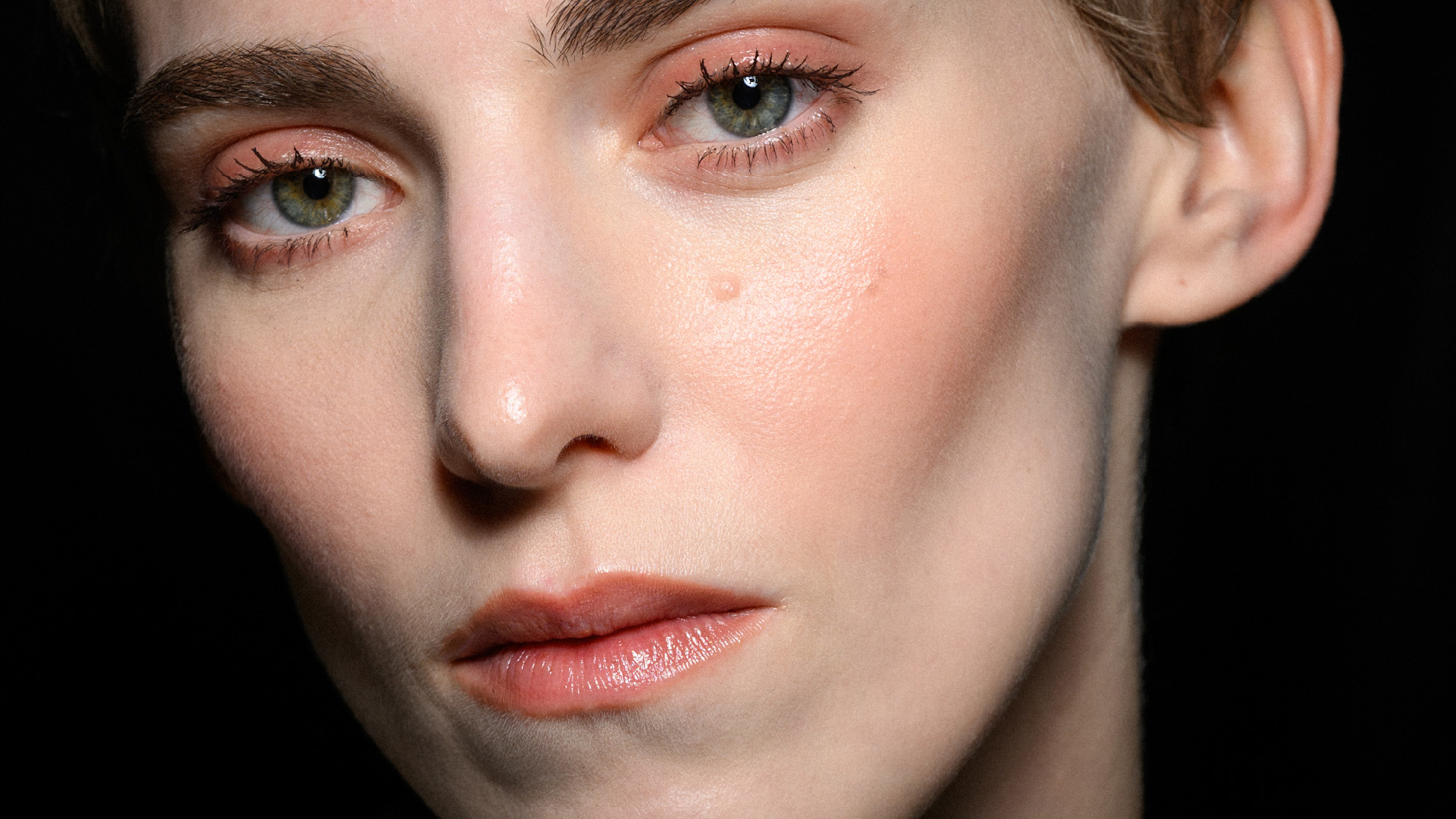
Dermaplaning is a popular exfoliation technique for the face that's likely popped up on your TikTok FYP more than once. It falls squarely into the strangely satisfying to watch category, with people using a sterile, precision blade to sweep away heaps of peach fuzz for silky-smooth results —and dramatic before-and-after pictures. Unlike traditional face shaving, which solely focuses on hair removal, at-home dermaplaning has both exfoliation and skincare benefits, which is a major part of its allure—and the trend shows no signs of slowing down in 2025.
As a beauty writer who’s been dermaplaning for years, I can confirm it's more than just a mesmerizing social media trend. "Dermaplaning is a non-invasive exfoliation procedure where a medical-grade scalpel or a specialized blade is used to gently remove the top layer of dead skin cells and fine vellus hair (peach fuzz) from the skin's surface," explains board-certified dermatologist Kristina Collins, M.D. "This process helps reveal a smoother, brighter complexion and improves the skin's ability to absorb skincare products." (A win for your ever-growing collection of face serums and rich creams.)
To curate this guide, I tested the most popular devices on the market and consulted with three board-certified dermatologists—Dr. Collins, Karan Lal, D.O., and Michelle Henry, M.D.—to discover the 12 best dermaplaning tools out there. They helped to answer your most pressing dermaplaning questions, including how often you can do it, its greatest benefits, whether it makes your hair grow back thicker, and more.
The Best Dermaplaning Tools
- Best Dermaplaning Tool Overall: DERMAFLASH LUXE+
- Best Sustainable Dermaplaning Tool: Leaf Shave The Dermaplaner
- Best Drugstore Dermaplaning Tool: Tweezerman Facial Razor
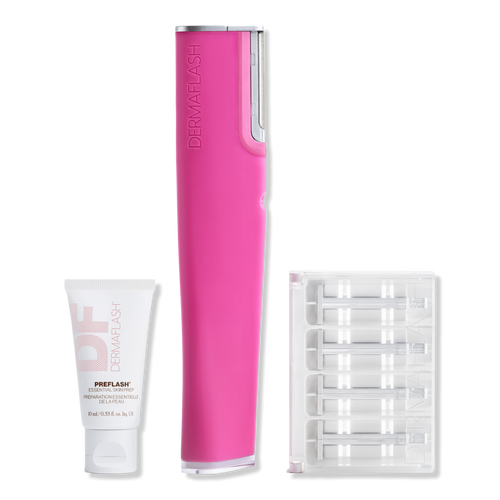
This dermaplaning device takes the top spot on my list for its effectiveness, sleek design, innovative technology—and for leading the charge in the dermaplaning world since its 2016 debut. Its microfine-bladed edge is carefully designed to prevent nicks and cuts, making it great for beginners, while the sonic vibration delivers powerful results that keep dermaplaning devotees (like moi) coming back for more. While it’s an investment, you only need to replace the single-use blades (not the device itself), so in due time, it'll pay for itself.
Who It's For: Those looking for a dermaplaning system that’s simple to use
What I Love: Features built-in safety measures to prevent nicks; Uses gentle vibrations for a more effective exfoliation (no pressing down as hard as you would with a manual razor); Includes a sleek storage base that doubles as a charging dock; Boasts vibration technology and two speed settings (low and high)
What I Don't: The Prepflash can be drying
Type: Electric razor
Replacement Blades: 4
Features: Charging/storage base; Charging cable; PREFLASH Cleanser
Review for MC: "I remember when I was first introduced to dermaplaning as a baby beauty editor, and this was the brand I experienced. That tracks, considering it basically dominates the industry in terms of how well-loved and recognized it is. But it’s not just the winner of the popularity contest for aesthetic reasons—it gets the job done well (and gently) for everyone, from beginners to dermaplaning pros. I use it ahead of special events when I want my skin to feel silky-smooth and my makeup to apply flawlessly, and I love that the charging base doubles as a storage solution." — Marisa Petrarca, Contributing Beauty Writer
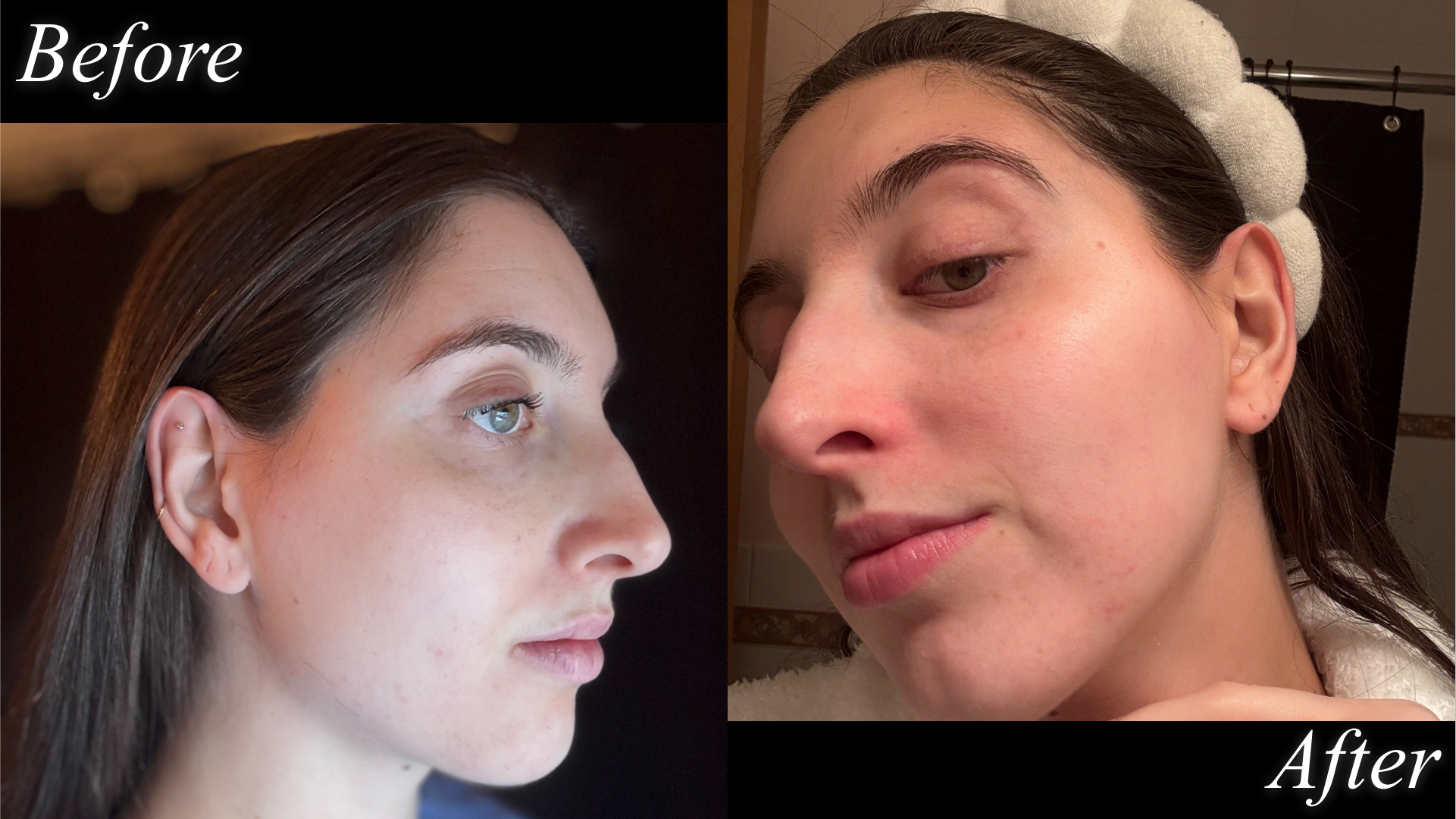
Contributing beauty writer Marisa Petrarca uses the DERMAFLASHLUXE+ Advanced Sonic Dermaplaning + Peach Fuzz Removal tool.
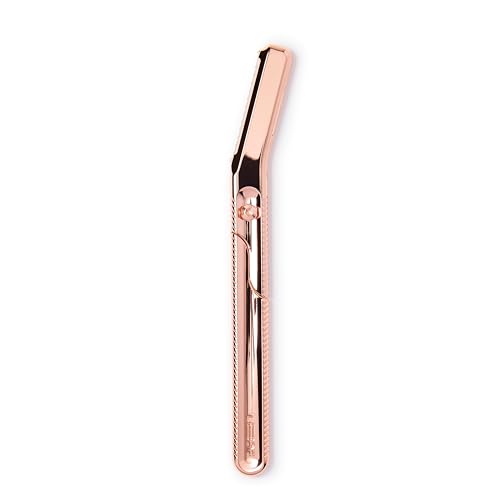
If you prefer the simplicity of a manual dermaplaning tool over devices with wires and charging bases, Leaf Shave's dermaplaning tool might just be your perfect match. Not only is it aesthetically pleasing, but it's also waste-free, thanks to its all-metal design and recyclable components—including the blades. It has a nice weight to it, which I've found makes it easier to achieve silky smooth skin without needing to press too hard. Plus, the weight makes it feel much more durable than other plastic options I've tried, as if it's something straight out of a pro's toolkit.
Who It's For: This dermaplaning tool is best for eco-conscious shoppers looking for a refillable and high-quality design
What I Love: Waste-free design; Refillable
What I Don't: Requires a more advanced user
Type: Manual razor
Replacement Blades: 2
Features: Sustainable all-metal design; Precision clip to shorten length of exposed blade; Recyclable refills
Review for MC: "I’ve had my eye on the stunning Leaf Dermaplaner for years, but I only recently put it to the test—and let me tell you, I wish I’d tried it sooner. As someone who’s always cheering on brands that go the extra mile for sustainability, I’m thrilled to report that this tool proves you really can have it all: sleek aesthetics, an eco-conscious design, and impressive results. Case in point: with the help of its precision clip, I managed to banish every bit of peach fuzz and fine hair from my upper lip in less than two minutes flat. And if you’re wondering about the results, just take a look at my (very vulnerable) before-and-after—it speaks for itself." — Marisa Petrarca, Contributing Beauty Writer
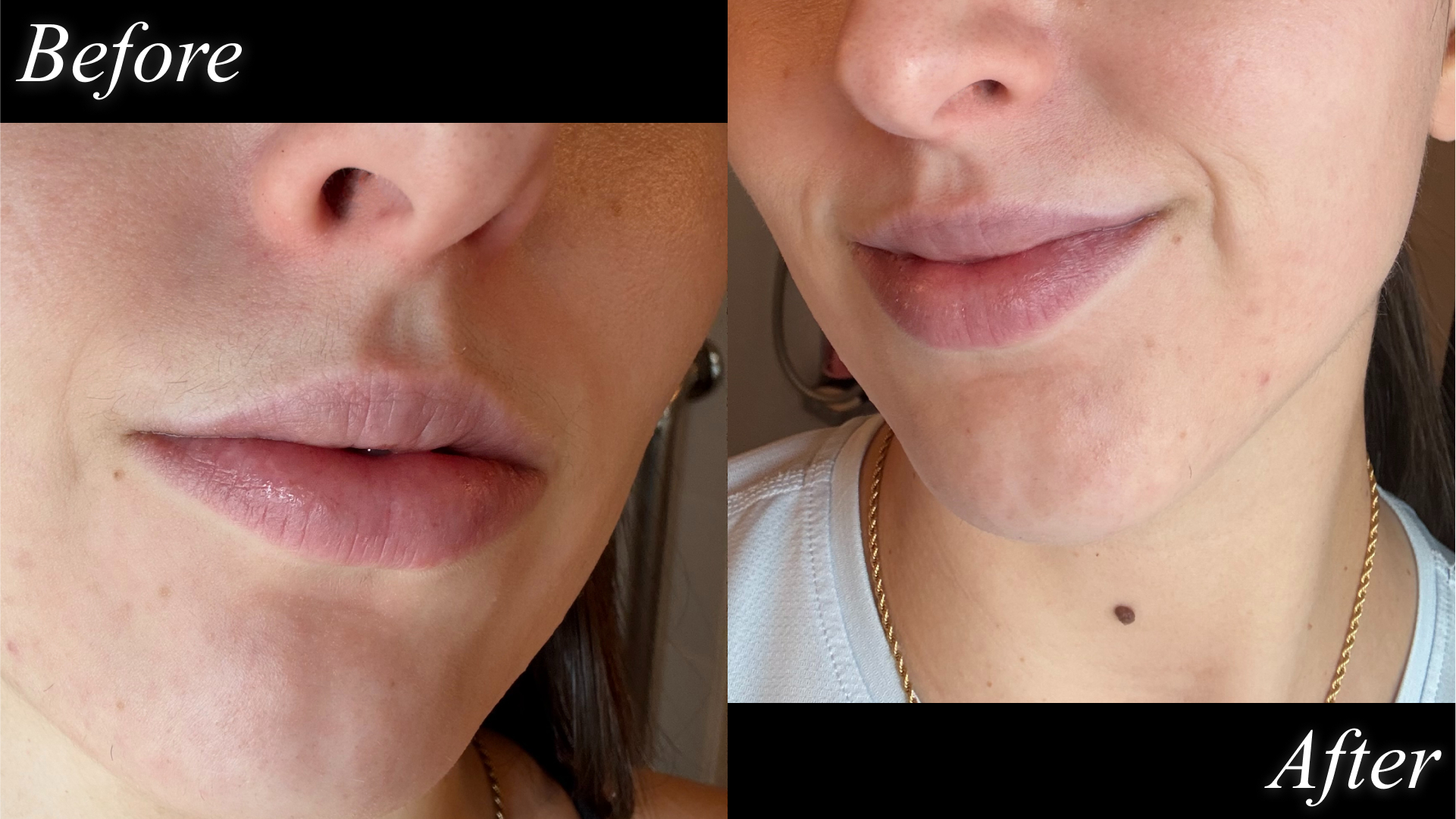
Contributing beauty writer Marisa Petrarca uses the Leaf Shave The Dermaplaner.
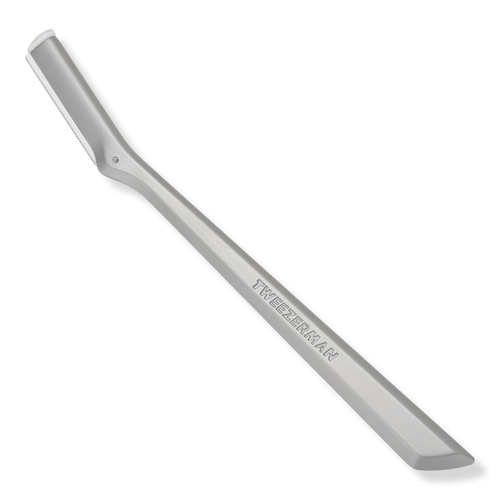
You’re probably already familiar with Tweezerman’s lineup of beauty tools—tweezers being the obvious standout—but let me introduce you to its stainless steel facial razor, if it’s not already on your radar. It features sharp, durable stainless steel blades, which Dr. Collins recommends for their long-lasting durability and hygienic properties. Likewise, it’s sturdy and effective, and multiple reviewers (myself included) have noticed that it leaves skin less temporarily irritated than other razors they’ve tried.
Who It's For: This tool is best for those looking for a budget-friendly dermaplaning option
What I Love: Durable; Reusable; Effective; Made with high-quality stainless steel; Dermatologist-recommended materials.
What I Don't: You'll want to replace it after a handful of uses
Type: Manual razor
Replacement Blades: 3
Features: Stainless steel handle; A safety cap; Safety lip that’s ideal for preventing cuts and gentle enough for sensitive skin
Review for MC: "As a longtime Tweezerman fan, I wasn’t surprised to find myself loving the brand’s Facial Razor. Its lash curler already holds a special place in my heart for its effectiveness at such a fair price point, and I feel exactly the same about this razor. It’s lightweight yet has just enough weight to feel steady in my hand, making peach fuzz removal smooth and seamless. I also appreciate that I can use the blades up to three times before swapping them out—it’s way more satisfying than having to replace them after every use. (Just don’t forget to clean the blades with a bit of alcohol after each use, pretty please!)" — Marisa Petrarca, Contributing Beauty Writer

Contributing beauty writer Marisa Petrarca uses the Tweezerman Facial Razor.
Other Dermaplaning Tools I Love
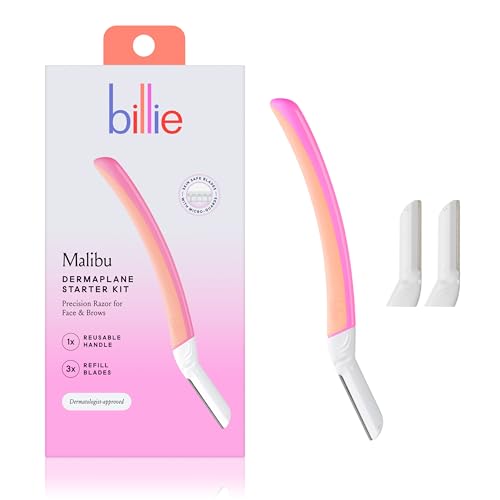
This starter kit from the body and shave brand Billie is the number-one bestseller among all of Amazon’s shaving and grooming products for women. It’s perfect for beginners, thanks to its entry-level price point, ergonomic design featuring a non-slip rubber grip, and an easy-to-follow Dermaplaning Guide with reference photos. But don’t let its beginner-friendly marketing fool you; this kit is just as effective as it is approachable, with stainless steel blades and micro-guards for a close, safe shave. You can also sign up for a blade refill subscription through Amazon or Billie’s website, so you’re always stocked.
Who It's For: While dermaplaners of all levels will appreciate its stainless steel blades, comfortable handle, and close shave, the Billie Dermaplane Starter Kit is ideal for beginners
What I Love: Budget-friendly; Entry-level option
What I Don't: Can be harder to get a sturdy grip
Type: Manual razor
Replacement Blades: 2
Features: Includes reusable handle with a non-slip rubber grip; Stainless steel blades with protective micro-guards; Step-by-step Dermaplaning Guide
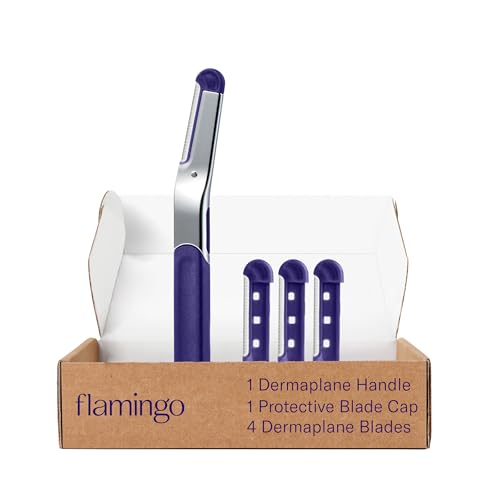
There are plenty of dermaplaning kits on the market right now (as you’ll see on this hefty list), but each one has its own unique features. Unlike the more lightweight Billie Dermaplaning Kit that’s better suited for beginners, I consider this one a great option for more experienced dermaplaners. The heavier handle offers better control and precision, ideal for those with more practice, whereas lighter options are typically gentler and beginner-friendly.
Who It's For: This dermplaning kit has a heavier handle than the aforementioned Billie razor kit, which is better for more experienced dermplaners who want to focus on achieving professional-level precision
What I Love: Very precise; Removes all hair
What I Don't: Would recommend to beginners
Type: Manual razor
Replacement Blades: 3
Features: Includes reusable weighted handle with no-slip grip; Protective blade cap; Stainless steel blades
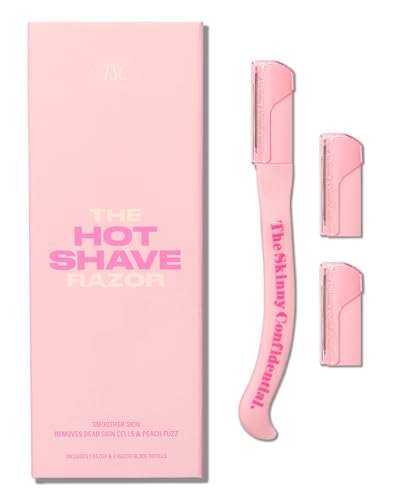
Plenty of shoppers warn that this dermaplaning tool’s blade is super sharp, but just as many praise it for delivering a super smooth shave. The brand did a great job balancing sharpness with thoughtful details, like an ergonomic design and a strategically placed finger divot, so you can keep a firm, comfortable grip while shaving. That said, this tool definitely isn’t beginner-friendly. Multiple users admit to nicking themselves when they didn’t have the technique down, so take your time and practice before diving in with this one.
Who It's For: This dermaplaning tool is for experienced dermaplaners who have mastered the technique and want one that fits comfortably in their hand
What I Love: Finger divot for comfortable grip; Sharp blade
What I Don't: If you're not careful, you'll knick your skin
Type: Manual razor
Replacement Blades: 2
Features: Includes refillable (and pink!) handle boasting an ergonomic handle with a finger divot
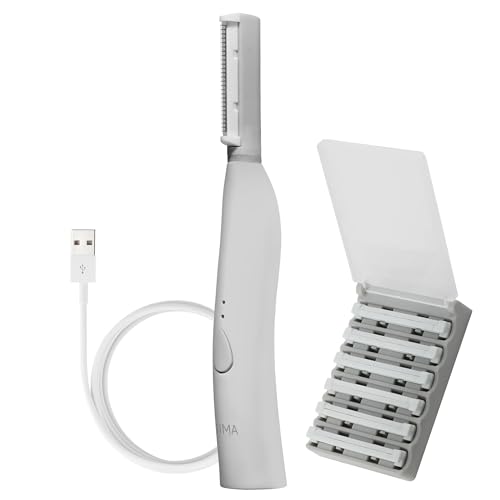
While it’s no secret that the DERMAFLASH Luxe+ is my favorite electric dermaplaning tool, I know the price tag can feel steep, especially if you’re not sure you’ll commit to monthly treatments long-term. Enter the Spa Sciences Sima Dermaplaning Tool, a highly rated electric option that’s more budget-friendly. It features three speed settings (low, medium, and high), so you can customize your experience based on your comfort level or slow things down for sensitive areas while speeding up for thicker peach fuzz.
Who It's For: This electric dermaplaning tool is best for anyone seeking a budget-friendly alternative to pricier devices and the ability to customize their experience with three adjustable speed settings
What I Love: Customizable speed; Affordable price point
What I Don't: Electric dermaplaning tools can feel intimidating
Type: Electric razor
Replacement Blades: 6
Features: Includes dermplaning tool; USB charging cord

Unlike many dermplaning tools that come with a precision clip to shorten a blade, this bundle from Jill comes with two blade options: a petite blade and a wide blade. I personally find this setup really convenient—especially for people like me, who are much more likely to replace a blade than keep track of a tiny cap. But that’s not the only thing that sets this kit apart. It also includes facial oil pads to prep your skin for an extra-smooth shave.
While the blades are designed for single use, the brand offers a refill bundle with both blades and wipes that you can subscribe to on Amazon or directly through its website.
Who It's For: This kit is a smart option for beginners who want a reusable tool that's beginner-friendly and offers the versatility of interchangeable precise and wide blades
What I Love: Two blade options; Comes with facial oil pads to prep skin; Bundle options are budget friendly
What I Don't: Chunkier handle can impact line of sight
Type: Manual razor
Replacement Blades: 0
Features: Comes with a pre-shave oil wipe and blade-cleansing cloth; Two different-size blades for dermaplaning; Reusable handle
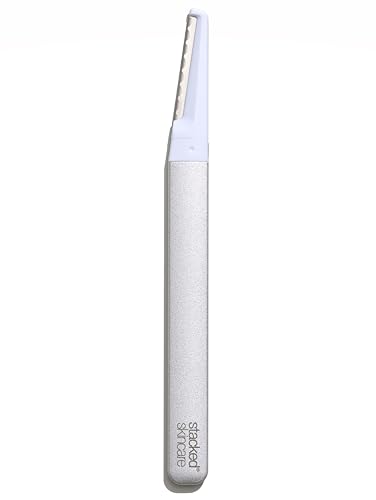
Love the idea of swapping out blades on your dermaplaning tool—whether you need a precise option or a wider one—but want a design that feels weightier in your hand than the lightweight plastic handle of the Jill tool? Check out this one from StackedSkincare. It's more of an investment, but is designed for more experienced users.
Who It's For: This tool is a smart option for more experience dermplaners looking for a reusable tool with the versatility of interchangeable precise and wide blades
What I Love: Feels sturdy in the hand; Good for experienced users
What I Don't: Doesn't come with replacement blades
Type: Manual razor
Replacement Blades: 0
Features: Includes reusable aluminum handle; Stainless steel blade; Regular and precision blade
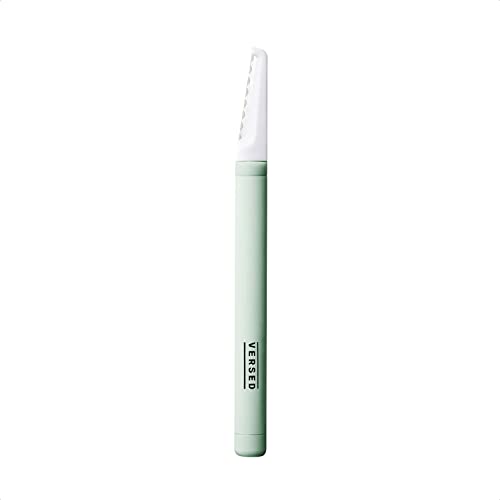
As a beauty writer, I always dive into reviews before testing a product to see what other shoppers have noticed. One Amazon reviewer shared, "I like that the handle is round and not flat," adding that, "it feels more secure in the hand." While I didn’t immediately think about the handle’s design, I have to agree—the rounded shape makes it feel more natural and comfortable to hold. Combined with its non-slip grip and lightweight design, this tool is a great pick if comfort is a top priority for your dermaplaning routine, along with the obvious no-brainers like a close, smooth shave.
Who It's For: This dermaplaning tool is a great option for those looking for a budget-friendly yet high-quality option
What I Love: Non-slip handle; Durable stainless steel blades; Resusable
What I Don't: Only comes with one replacement blade
Type: Manual razor
Replacement Blades: 1
Features: Lightweight handle with a rounded shape and a non-slip grip; Protective safety cap
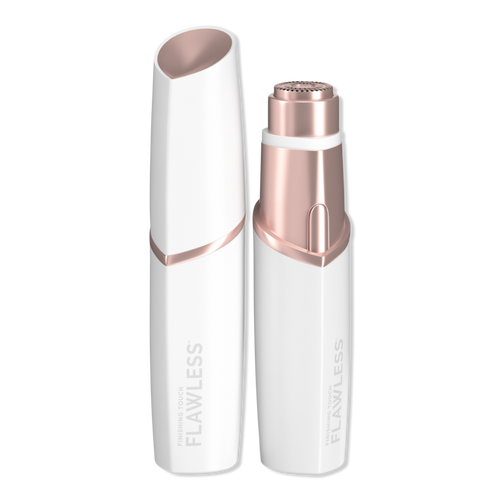
If hair removal is your main focus over exfoliation, the Finishing Touch Flawless Facial Hair Remover might be your best match out of all the (incredible) options on this list. Though it isn’t a traditional dermaplaning device because it doesn’t use a blade to exfoliate and remove hair simultaneously, it’s worth including for how easy it is to use and how well-adored it is for removing peach fuzz and fine hairs. Instead of a traditional blade, it features a spinning mechanism focused solely on hair removal. It’s painless, ridiculously easy to use (just glide it across your skin in circular motions), and takes up next to no space in your vanity.
Who It's For: For anyone looking to remove peach fuzz and fine hairs without the intimidation factor that often comes with traditional bladed dermaplaning tools
What I Love: Offers hair removal; Sleek design
What I Don't: More expensive than others on this list
Type: Electric razor
Replacement Blades: n/a
Features: Portable design; LED light for precision; Hypoallergenic 18-karat gold plating
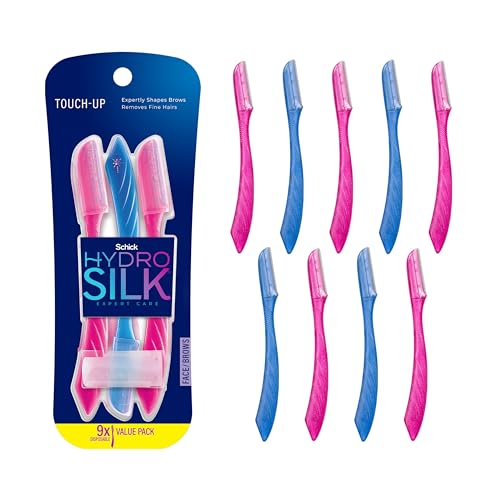
While disposable razors aren’t the most eco-friendly option, there’s no denying that this value pack of dermaplaning tools is a favorite among Amazon shoppers. Each razor comes with a precision cover that reveals only a small portion of the blade that's convenient for brow touch-ups. And without the cover, it works just like a traditional dermaplaning tool, removing peach fuzz and gently exfoliating skin. What we appreciate most about this set is the brand’s recycling program, which lets you responsibly recycle your razors. It does require a little extra effort, but we’re crossing our fingers that its thousands of devoted fans are taking full advantage.
Personally, I love the idea of packing one or two of these for extended travels. They’re lightweight, slim, and far more portable than a heavier device that requires wires or a charging base.
Who It's For: This value pack of disposable dermaplaning tools is perfect for anyone looking to dip their toes into the dermaplaning trend without committing to a higher-priced device
What I Love: Lightweight; Compact option that’s easy to toss into a travel bag
What I Don't: Not enviornmentally friendly
Type: Manual razor
Replacement Blades: n/a
Features: Includes blade cover for precision shaping (especially helpful for touching up your brows); Slim, portable size
What to Look for In a Dermaplaning Tool
When it comes to shopping for a high-quality dermaplaning tool, the three dermatologists I consulted for this piece unanimously agreed that safety features are non-negotiable, meaning, tools with built-in mechanisms to prevent nicks or cuts should top your list. Dr. Lal recommends an electric dermaplaning device like the DERMAFLASH Luxe+ Advanced Sonic Dermaplaning Tool, which uses controlled pressure to eliminate the risk of pressing too hard; though plenty of manual razors have protective features, too.
Dr. Collins also recommends a device with stainless steel blades, deeming the material the best blade choice for dermaplaning. She explains, "Stainless steel is highly durable and maintains a sharp edge longer than other materials, ensuring a precise and effective exfoliation process." Likewise, it's great for hygiene and safety because it's "naturally resistant to corrosion, rust, and bacterial growth" and "easy to steralize. Plus, it's non-reactive and hypoallergenic, which reduces the risk of irritation or adverse reactions on sensitive skin."
Finally, you should look for an ergonomic design, though comfort is highly personal. If you're new to dermaplaning, look for a tool with a non-slip grip to help you maintain control. Seasoned pros, on the other hand, may want a tool that you can swap between precision blades and wide ones for customization.
What Is the Difference Between At-Home and In-Office Dermaplaning?
The difference between in-office and at-home dermaplaning is straightforward: in-office treatments are performed by a professional, while at-home dermaplaning is done by you—and it’s intentionally less intense.
"In-office dermaplaning is performed by a licensed dermatologist or aesthetician who uses a medical-grade scalpel with advanced techniques to ensure precision and safety," Dr. Collins elaborates. "They can address specific skin concerns and customize the treatment."
At-home dermaplaning tools, on the other hand, "are less sharp for safety reasons, making them suitable for general maintenance but less effective for deep exfoliation," she continues. "Professional treatments typically yield more dramatic results."
What are the Benefits of Dermaplaning?
- Exfoliation and Smoother Skin Texture: "Dermaplaning removes dead skin cells [as well as peach fuzz and fine hairs], resulting in a smoother and more luminous complexion," says Dr. Collins.
- Seamless Makeup Application: "It also creates a smooth canvas for makeup for a more even and natural finish," Dr. Collins adds.
- Improved Product Absorption: Post-dermaplaning, Dr. Henry tells me that your skin will "more readily absorb the [skincare] products you use because you have gotten rid of that peach fuzz and those dead skin cells."
How Often Can I Dermaplane?
"Most people can safely dermaplane every three to four weeks," says Dr. Collins. "This frequency allows enough time for the skin to regenerate a healthy layer of dead cells without over-exfoliating. However, individuals with sensitive skin may need longer intervals between sessions."
Dr. Lal and Dr. Henry, however, suggest spacing sessions a bit further apart, namely every four to six weeks. ("Dermaplaning too often can disrupt your skin barrier and precipitate breakouts," Dr Lal warns.)
Ultimately, I recommend consulting your dermatologist or aesthetician for personalized advice, but somewhere between three to six weeks is the sweet spot, according to the derms I tapped for this piece.
How Do I Dermaplane?
The dermaplaning technique may vary slightly depending on the device, but the general rule of thumb is mostly consistent. Always start with clean, dry skin and then, holding the blade at a 45-degree angle, use fast, short strokes, focusing on one small section of your face at a time. When you're done, follow up with a gentle, fragrance-free moisturizer to calm and hydrate your skin.
Will Dermaplaning Make My Hair Grow Back Thicker?
All three board-certified dermatologists consulted for this piece confirmed that dermaplaning does not cause hair to grow back thicker, with Dr. Lal calling the myth an "old wives' tale." Dr. Collins breaks it down further: "Hair regrowth might feel slightly stubbly at first because the blade cuts the hair at a blunt angle, but the texture, color, and growth rate of the hair remain unchanged. This misconception arises because the hair feels different as it grows back, not because its structure has changed."
Why Trust Marie Claire
Marie Claire is an expert in skin care and hair removal, having covered topics ranging from the ultimate guide to hair removal methods and the best tweezers of 2025 to sugar waxing and facial hair removal products.
Beauty Writer Marisa Petrarca brings nearly a decade of expertise to this story and has tested numerous dermaplaning devices. For this story, she consulted three board-certified dermatologists for their insight into what to look for in a dermplaning product, its benefits, and more.
How We Tested
For this story, we sourced editor favorites and tested over 15 dermaplaning tools. We scoured the Internet for customer reviews to ensure each device was rated highly, and consulted with lash experts. We evaluated each option based on type, features, overall performance, and more.
Meet the Experts
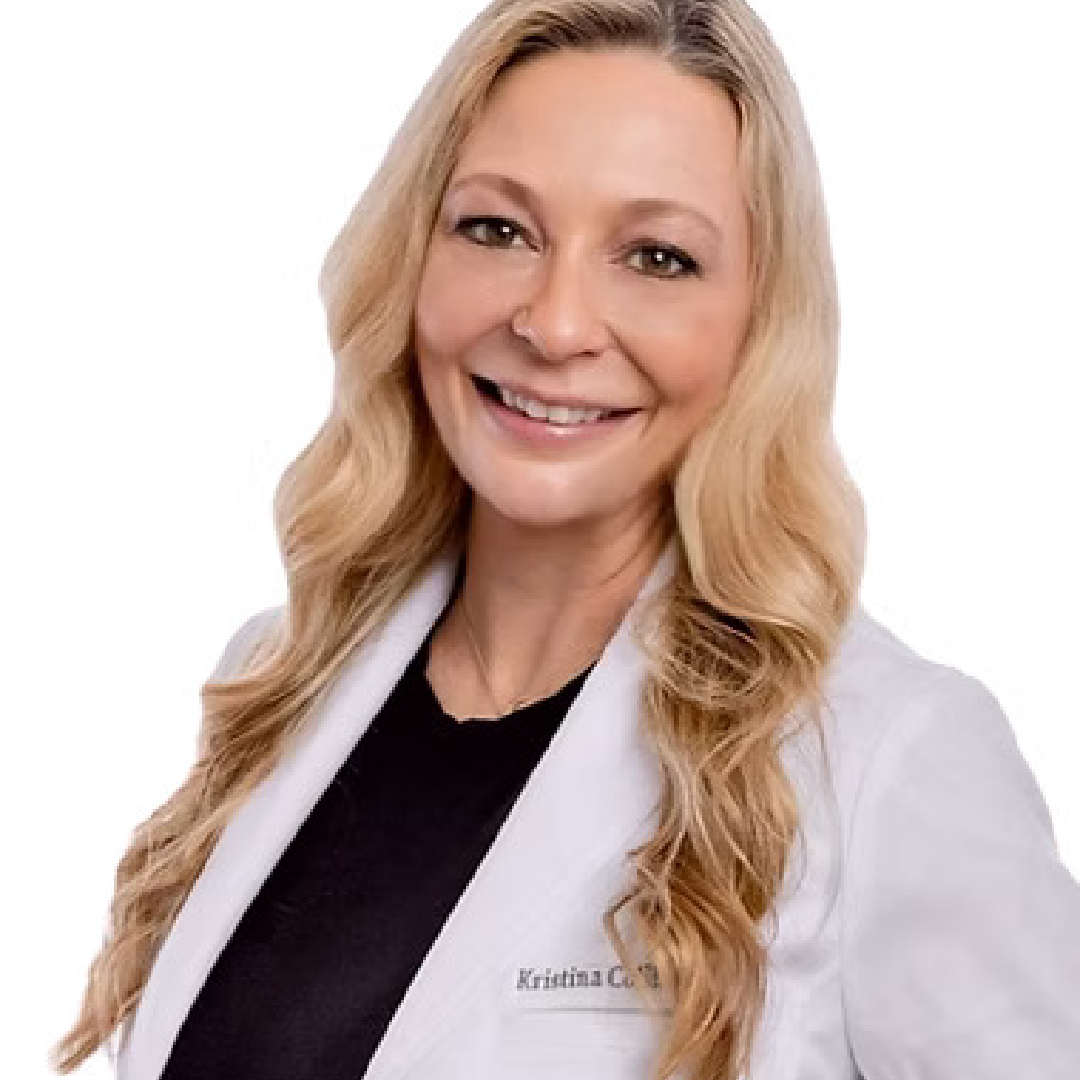
Kristina Collins, MD, is a double-board-certified dermatologist in Austin, Texas, specializing in Mohs micrographic surgery, as well as surgical and cosmetic dermatology. She is also the co-founder of Austin Skin Physicians and founder of Foy by Dr. Kristina Collins MD.
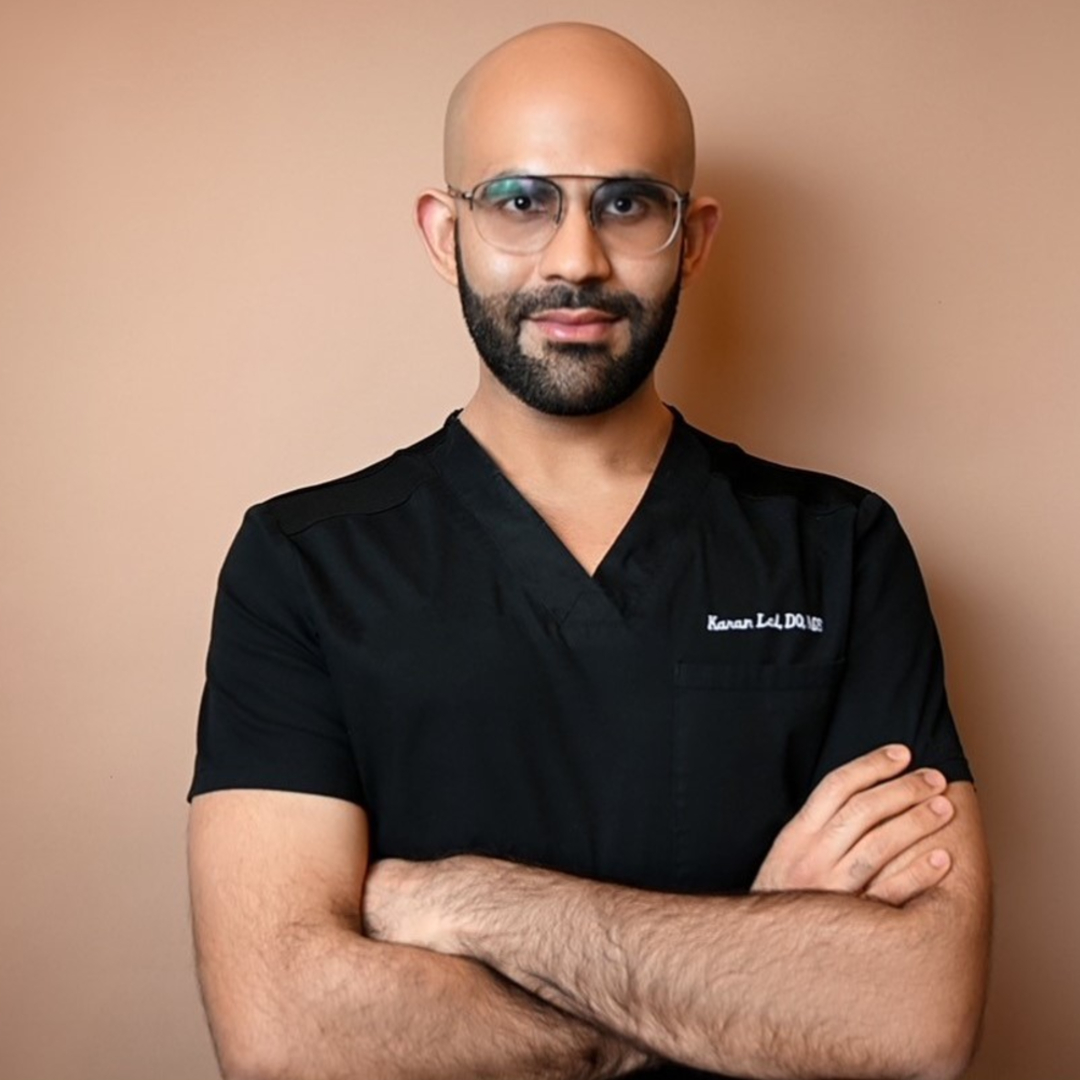
Karan Lal, DO, is a double board-certified dermatologist based in Scottsdale, Arizona, specializing in pediatrics and adult dermatology, laser surgery, and soft tissue filler augmentation.

Michelle Henry, MD, is a board-certified dermatologist based in NYC specializing in Mohs micrographic surgery, laser surgery, and cosmetic dermatology. She's also the owner and founder of Skin & Aesthetic Surgery of Manhattan.
Get exclusive access to fashion and beauty trends, hot-off-the-press celebrity news, and more.

Marisa Petrarca is a writer and editor based in Saint Paul, Minnesota, specializing in beauty, wellness, fashion, and lifestyle. She previously served as the Senior Beauty and Fashion Editor at Grazia USA and Beauty and Style Editor at Us Weekly. Her expertise spans breaking beauty news, shopping roundups, product reviews, and explainer articles on popular topics in skin, makeup, and aesthetics. Her work has been featured in PS, Cosmopolitan, Allure, NewBeauty, InStyle, and The Zoe Report, among others. Marisa holds a bachelor's degree in English literature from Wagner College. Follow her on Instagram @Marisa Petrarca.